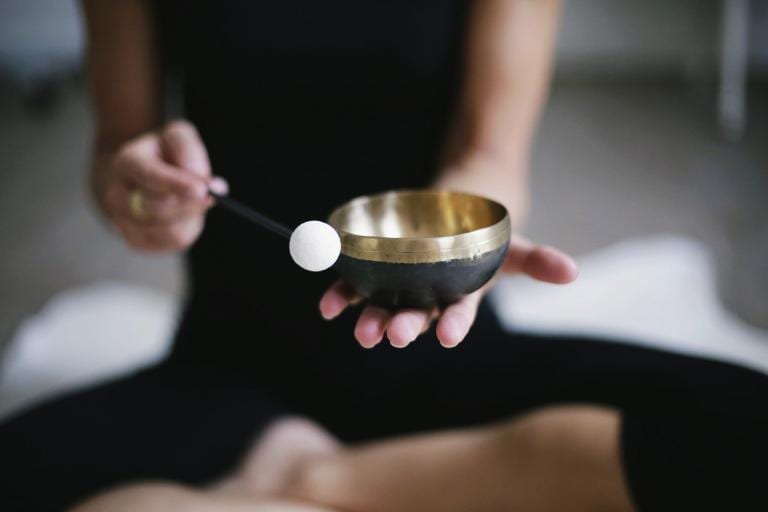When I began learning about witchcraft twenty years ago, one of the first things I began studying is meditation. It became an important part of my daily practice, helping me to learn focus, etc. But over the years, I have learned that chanting can be a valuable aid in one’s meditation practice or on its own. In fact, it can be the one thing that helps return focus when my mind starts a-wandering.

Chanting: A Brief Definition
Chanting is a centuries-old practice found in multiple regions, cultures, religions, and spiritual traditions. It is a form of rhythmic speaking or singing focusing on a word, phrase, or sound. One or two pitches are generally used and are repetitive. A chant can be simple or complex with repeating subphrases. You can think of chants as stylized speech or music.
When performing a chant, the singer/speaker may draw from sacred texts (psalms, hymns, verses), the names of deities, affirming words or phrases, and sounds (such as the “ohm” or basic vocalizations).
Chanting is practiced in African, Aboriginal, and Native American tribal cultures. It is found in Buddhist, Vedic, Bahai, and Muslim faiths. Gregorian chant finds its origin in the Catholic church around the 9th to 10th centuries. Chanting is also used in the Greek Orthodox, Lutheran, and Anglican churches. And that’s just to name a few of the religions, traditions, and spiritualities (such as Pagan or Witchcraft) that utilize chant.
The purpose of chanting is to find a greater connection to the spiritual world. For those who use sacred text, it opens the heart and mind to the lessons those words offer. Chanting the name of a deity draws one closer into communion with them. For those who chant or sing a sacred sound, it draws the chanter into greater awareness of self and the universe.

The Benefits
In the same manner as meditation, chanting offers a wealth of health benefits, not to mention may be easier for those who find meditation a challenge. According to studies, those who use chant improve overall focus while decreasing stress and anxiety. According to a 2016 study, chanting “om” for ten minutes improves one’s mood and “increases the feeling of social cohesion.”
Another study from 2018, found chanting to be a beneficial treatment for veterans experiencing PTSD. Makes sense. Recently, I watched TINA, a documentary about the life and career of Tina Turner. In the film, she credits Buddhism and chanting as what helped her escape and heal from an abusive relationship with Ike Turner. She has maintained a daily chanting practice for forty years.
As mentioned, there are people who avoid meditation because it is difficult for them. Their mind wanders, they do not like sitting still, etc. Fair enough. So, how about giving chanting a try? It really is not difficult and much like a walking meditation, a person does not have to be sitting or even keeping still to benefit from chant.

The Point is to be Focused
Let me share a story with you. A couple of years ago, I had some time to kill at Michigan Pagan Festival. Feeling a need for an emotional break, I decided to walk a labyrinth that had been set up. While walking the path, I began to feel overwhelmed, unsure of how to proceed, so I started chanting “Hekate Enodia, Hekate Kleidoukhos. Hekate Lampadios.”
With every breath of the chant, my head felt clearer and emotions calmer. By the time I reached the center, the goddess joined me. I spent time with her, seeking wisdom and guidance. When the time came to leave, I was able to make my way out with confidence. So, you can chant while engaging in another activity such as walking. The point is to be focused.
Most days, I chant to connect with my deities but I have a separate meditation practice as well. Closing my eyes. Settling my breathing. Being intentional in my space and time. And like many others, there are days it does not work because thoughts interrupt. What do I need to make for dinner? Are there errands to run? What is that song that keeps niggling at my brain?
On days like this, no matter how many times I recognize them and move on, more thoughts will follow to distract me. But chanting helps put the kibosh on wandering thoughts when they occur during meditation. When thoughts creep in, I will chant a word, affirmation, or name of a deity. Sometimes I will hum the “om.” The chant leads me back into focus.

How Do You Chant?
The biggest question is how do you start? What kind of chant works best for you? The most obvious answer is to start with the “Om.” You can begin with a hum that you sustain for one long breath. Then add the syllable, dragging out the sound before humming on the “m” at the end. The steps are:
- Take a slow, deep breath in. From the belly, filling the lungs.
- Release the breath slowly with the “o” on a singing pitch sound, sustaining as you breathe out.
- As you near the end narrow the sound to the “m” until you come to the end of the breath.
- Repeat.
There are videos that you can chant along with also.
Another option is to chant the name of a deity, as I did with the example listed above. In fact, that is my daily chant and how I began that dedicated practice. You can do this on a breath (pronouncing the syllables on a slow inhale and exhale) — a technique I learned from Cyndi Brannen for chanting Hekate’s name.
Or you can speak or sing the name of the deity in a slow, repetitive manner. An example:
- Take a slow, deep breath in. From the belly, filling the lungs.
- Say the deity’s name on a slow exhale, drawing out the syllables.
Another way to chant is to speak a mantra or phrase. This could be a positive affirmation:
- I am kind.
- I am generous.
- I am curious.
Or you can repeat a sacred line from a religious text. There are many ways to create a chanting practice.
Additionally, you do not have to chant out loud if it is not convenient or you feel weird doing so. Silent chanting in your head, a low hum, it all works too.
How Long Do I Chant?
That is up to you. You can set a timer for five minutes to start. See how it goes, then add minutes every day. You can use a set of mala or rosary beads, repeating the mantra, prayer, name, or sound for each bead. Experienced people can chant for hours but you may want to keep it simple and short. Whatever is best for you and your schedule.
Where you chant is also up to you but try to find a space where you have some time to yourself, even if it is in a park or while taking your dog for a walk around your neighborhood.
But I’m Not Religious. Or I Don’t Believe In Deities.
No problem. You can still use a chant to connect with your inner wisdom, bring peace and clarity to your mind, or just calm your spirit. Stick to a sound, positive affirmation, or something that works for you. Sing it, speak it, hum it. And focus your mind on your intention to relax.
Meditation and chanting are not for religious or spiritual people alone. Anyone can benefit from quieting the mind, tuning into the body, and just being “aware” in the moment.

















